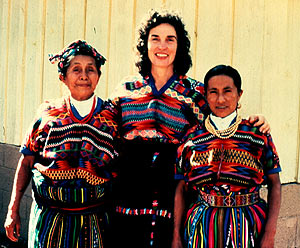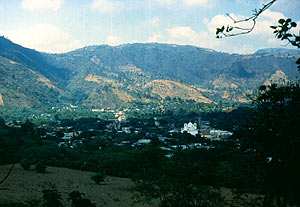|
|
|
| . |
 |
| . | |
 |
|
| . | |
| . |
|
| . | |
| The is the journal that Margot Blum Schevill wrote while she learned Maya backstrap weaving. She leaned from Rafaela, Edgar's mother. (See Edgar's Story). | |
| . | |
| The spring of 1978. I was on my way to San Antonio Aguas Calientes, in the department of Sacatepéquez, Guatemala. Why was I going there? A serendipitous connection made the previous year through a casual meeting with one of my husband's former students led me to Doña Rafaela Godinez, well known weaver and teacher, who lives in this town only 12 km from Antigua. My husband and I rented a furnished house off of the road from Antigua to Guatemala City, in a neighborhood known as Santa Ines. We planned to stay three months. While Jim works on a novel, I will study weaving as a participant-observer, my field work for a Master of Arts in Anthropology from Brown. | |
| Back to the community of San Antonio Aguas Calientes, Saint Anthony of Hot Waters. Up early, I catch a camionetta to the market and into an over loaded bus with most women dressed in traje signifying their affiliation with San Antonio. La Perla (the name of the bus) rattles over the short 12 km; first down a paved road, through Cuidad Viejo, a ladino town and the second capital of Guatemala. We turn onto an unpaved, dusty road through San Miguel Dueñas, a mostly ladino pueblo devoted to coffee production, and then to the crest of a hill looking down on the drained lake bed around which San Antonio had grown. According to my guide book, the population is 3174, 95% indigenous or Maya. The previous year on a guided tour I visited this community, well known for its fine weavings. On both sides of the hill were small shops or tiendas where women sold textiles, mostly from their own community but also from elsewhere. The color, designs, and beautifully dressed women made a strong impression on me. I was in a tourist bus, and our guide did not give us too much information and little time. I did manage to buy a beautiful child's huipil and marveled at the fine patterning. | |
| . | |
 |
|
| This time I am on my way to the first meeting with Rafaela and, I hope, my first weaving lesson. I am very excited. I know that she agreed to teach me—she had other students, and through our intermediary, she had a vague date in mind when I would appear. I do not know where she lived, so when I arrive I asked some women where her house is. Curious glances, some furtive whispering, but I am directed to a wooden house with fences on both sides. I knock on the gate. No one answers. I look at the women who had indicated the house, and they laugh, I wave, and they gesture—knock again. Her son Edgar, then sixteen years, comes to the door. He is medium height, longish black hair , handsome face, dressed in western-style clothing. He says she was away but will be back by midday. I brought a book with her picture in it, and I show it to him. He smiles. I leave to look for an anthropologist colleague, Sheldon, but he is not home either. So I settle down to wait for Rafaela, take a photo, and begin to write in my journal. | |
| Back to Rafaela's house. She is expecting me. Her husband Francisco lets me in. She seems to be in her mid-thirties, perhaps Francisco is younger. She has two older children, a daughter eighteen named Graciela, and Edgar, fifteen, who I met. There is a baby, Marco Tulio, two years, and Francisco, Edgar's father is his father. I meet her mother, Vicenta, in her sixties; Rafaela, Graciela, and Vicenta are Godinez, Francisco, Edgar, and Marco Tulio are Apen. The family! I give her the book with her picture in it. She tells me about her first trip to the U.S. in 1976 to Brookfield Center. | |
| I look around and make mental notes about the home layout: wooden fences, yellow wall of adobe and wooden room where Edgar sleeps in which there is an altar. They are Catholic, and she asked me if I was. We talked about religion a little, and I realize that this is a very important part of family life with special fiestas and processions. I look at the rest of the homestead around a large open space with various rooms created by petate mats, poles, and overall laminated tin roofs. Roofs used to be of tile, but in the 1976 earthquake people were killed by the falling tiles. We go into Edgar's room, and Rafaela shows me the book by Lena Bjerregaard, also a hanging with black background and large birds, which I learn are quetzales, and blue vertical and patterned sections. She names the designs in Spanish and points out one—jaspe saying that's where we would begin. But not today! The weaving was incomplete and will be sold that way. Next she took a traditional huipil she had woven with a maroon base like the one I bought the year before. Cotton and sedalina (I learned that was pearlized cotton), but no silk are in the fibers. It is beautifully woven and she would sell it for $60 (in the 1970s the quetzal and the dollar were one for one). | |
| I ask her about her clothing or traje. Her huipil is similar to those worn by other women I had seen. It has ribbon binding on the neck and sleeves, a zipper in the front so she can nurse her little boy. The skirt is called falda and is of treadle-loomed cloth from Totonicapán; some stripes are black-and-white ikat or jaspeado, other stripes were bright colors of wool or acrylic. She tells me she wove her belt or faja, wide stripes and an older style, also her utility cloth or tzute, which she wears on her head in the sun. Underneath the huipil she wears a white blouse or cotón. Gold-like beads and earrings complete her traje. She is tiny and slender, and her mother Vicenta is dressed in the same way. Not her daughter, Graciela. | |
| I explain about working in a museum and wanting to buy textiles. Always a business woman, she offers me a skirt as she has an extra. Vicenta is urging her on. I say más tarde [later]. I want to know if there are different outfits for other occasions, and the answer was no. Thinking about that, she says that if she was invited elsewhere, she has another huipil to wear. I had read about the cofradías or religious organizations that required special dress. I understand that there are no cofradías in San Antonio, but I suspect that I have misunderstood her. We make a date to meet the following Monday. I will be there from 10-3 for $3 that includes lunch. I show her photos of my looms and we talk of dyeing, natural colors, and spinning. She uses all synthetic-dyed pre-spun cotton and does not spin. She calls herself "an artist" many times. She wants to return to the U.S. again and teach. She does well financially away from Guatemala and adds much to her self esteem. | |
| I see Rafaela as a performer in the way she presents herself, her work, the Bjerregaard book with photos of her, the way she introduced her family. We were in an in-between relationship akin to Victor Turner's concept of liminality. Because of her warmth of personality and experience elsewhere, we moved right into the next stage of a relationship and did not waste too much time on preliminaries. In my conversations with Maya people, they do not stop the conversation. I say I have to leave and do so catching the bus, shopping in the mercado, luckily catching the camionetta and I was home! What a day! | |
| . |
|
|
To contact us write: Arte Maya Tz'utuhil, P.O. Box 40391, San
Francisco, CA 94140. Telephone: (415) 282-7654.
Email me at
All paintings and photographs Copyright © 1988–2015 Arte Maya Tz'utuhil |